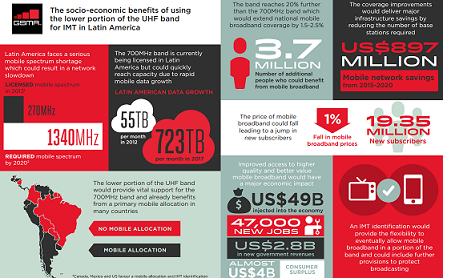Today, the GSMA and the Telecom Advisory Services launched a new report on the social and economic benefits of using the lower portion of the UHF spectrum band (470-698MHz) for mobile services in Latin America.
The report reveals how an increase in mobile broadband coverage would significantly contribute to GDP, job creation and tax contribution in the region.
 In order to meet the exploding demand for mobile data, we need to identify an additional 600-800 MHz at the pivotal World Radiocommunication Conference in November 2015, where governments from around the world will meet to agree on changes to international spectrum allocations.
In order to meet the exploding demand for mobile data, we need to identify an additional 600-800 MHz at the pivotal World Radiocommunication Conference in November 2015, where governments from around the world will meet to agree on changes to international spectrum allocations.
However, current proposals from CITEL have only identified an additional 90MHz for International Mobile Telecommunications (IMT). This is not enough to support the future growth of mobile broadband in Latin America.
The lower part of the UHF band or “second Digital Dividend” – the spectrum that is freed up after analogue television broadcasting switches to a digital transmission – represents a key opportunity for mobile. It has ideal coverage qualities for rural areas and offers extra capacity.
The Digital Dividend band has already been allocated to mobile services, as well as broadcast, in several countries in the region and it is clear that the band can be used successfully for both.
The results from this new study show that the following economic benefits could be generated as a direct result of using the 470-698MHz band for mobile broadband services in Latin America:
- Direct and indirect contribution to GDP of up to US $49 billion;
- Creation of more than 47,000 new jobs both directly and directly;
- Additional tax contribution in excess of US $2.8 billion;
- More optimal deployment and operation of new networks, resulting in a reduction of capital investment of US $897 million compared to deployment of infrastructure in higher frequency bands, while achieving better coverage;
- A consumer surplus of US $3.8 billion.